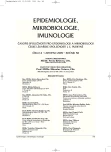-
Medical journals
- Career
Antibiotic Resistance and Biofilm Formation in Pseudomonas aeruginosa Strains Isolated from Patients with Urinary Tract Infections
Authors: L. Černohorská; P. Sláviková
Authors‘ workplace: Mikrobiologický ústav, Brno
Published in: Epidemiol. Mikrobiol. Imunol. 58, 2009, č. 4, s. 154-157
Overview
Altogether 118 Pseudomonas aeruginosa strains isolated from urine of patients with urinary tract infection were tested by the disk diffusion method for susceptibility to ciprofloxacin, ofloxacin, gentamicin, amikacin, colistin, meropenem, imipenem, piperacillin/tazobactam and ceftazidime. All strains were also screened for biofilm formation using a modified Christensen method.
Eighty-eight, i.e. 74.6 %, of the tested strains were resistant to ofloxacin, 86 (72.9 %) to ciprofloxacin and 70 (59.3 %) to gentamicin. Forty strains (33.9 %) were resistant to imipenem, 42 strains (35.6 %) to meropenem, 14 strains (11.9 %) to amikacin, 2 strains (1.7 %) to colistin, 35 strains (29.7 %) to piperacillin/tazobactam and 41 strains (34.7 %) to ceftazidime.
Co-resistance to ofloxacin, ciprofloxacin and gentamicin was detected in 67 strains (56.8 %) while 12 strains (10.2 %) were resistant to most tested antibiotics, with the exception of amikacin and colistin.
Biofilm formation was found in 41 strains (34.7 %), more precisely in 23 of 46 inpatient strains and 18 of 72 outpatient strains. Eight (66.6 %) of 12 polyresistant strains were biofilm producers.Key words:
P. aeruginosa – fluoroquinolones – gentamicin – aminoglycosides – urinary tract infection – biofilm.
Sources
1. Christensen, G. D., Simpson, W. A., Bisno, A. L., Beachey, E. H. Adherence of slime-producing strains of Staphylococcus epidermidis to smooth surfaces. Infect Immun, 1982, 37, 318-326.
2. Christensen, G. D., Simpson, W. A., Younger, J. J., Baddour, L. M. et al. Adherence of coagulase-negative Staphylococci to plastic tissue culture plates: a quantitative model for the adherence of staphylococci to medical devices. J Clin Microbiol, 1985, 22, 996-1006.
3. Costerton, J.W., Stewart, P. S., Geenberg, E. P. Bacterial biofilms: A common cause of persistent infections. Science, 1999, 284, 1318-1322.
4. Černohorská, L., Votava, M. Determination of Minimal Regrowth Concentration (MRC) in clinical isolates of various biofilm-forming bacteria. Folia Microbiol, 2004, 49, 75-78.
5. Darouiche, R. O. Prevention of infections associated with vascular catheters. Intensive Med, 1999, 36, 349-354.
6. Hoyle, B. D., Costerton, J. W. Bacterial resistance to antibiotics: the role of biofilms. Progr Drug Res, 1991, 37, 91-105.
7. Lu, T. K., Collins, J. J. Dispersing biofilms with engineered enzymatic bacteriophage. Proc Natl Acad Sci USA, 2007, 104, 11191-11202.
8. Monden, K., Ando, E., Iida, M., Kumon, H. Role of fosfomycin in synergistic combination with ofloxacin against Pseudomonas aeruginosa growing in a biofilm. J Infect Chemother, 2002, 8, 218-226.
9. Monzón, M., Oteiza, C., Leiva, J., Amorena, B. Synergy of different antibiotic combinations in biofilms of Staphylococcus epidermidis. J Antimicrob Chemother, 2001, 48, 793-801.
10. Raad, I., Hanna, H. Intravascular catheters impregnated with antimicrobial agents: a milestone in the prevention of bloodstream infections. Support Care Cancer, 1999, 7, 386-390.
11. Song, W., Woo, L., Kim, J. S., Lee, K. M. In vitro activity of β-lactams in combination with other antimicrobial agents against resistant strains of Pseudomonas aeruginosa. Int J Antimicrob Agents, 2003, 21, 8-12.
12. Stewart, P. S., Costerton, J. W. Antibiotic resistance of bacteria in biofilms. Lancet, 2001, 358, 135-138.
13. Stone, J. H., Gabriel, M. M., Ahearn, D.G. Adherence of Pseudomonas aeruginosa to inanimate polymers including biomaterials. J Ind Microbiol Biotechnol, 1999, 23, 713-717.
14. Tolker-Nielsen, T., Brinch, U. C., Ragas, P. C., Andersen, J. B. et al. Development and dynamics of Pseudomonas sp. biofilms. J Bacteriol, 2000, 182, 6482-6489.
15. Trautner, B. W., Hull, R. A., Darouiche, R. O. Colicins prevent colonization of urinary catheters. J Antimicrob Chemother, 2005, 56, 413-415.
Labels
Hygiene and epidemiology Medical virology Clinical microbiology
Article was published inEpidemiology, Microbiology, Immunology

2009 Issue 4-
All articles in this issue
- Prevalence of Glycoprotein B (gB) Genotypes in the Patients with High Risk of Symptomatic Cytomegalovirus Infection
- Antibiotic Resistance and Biofilm Formation in Pseudomonas aeruginosa Strains Isolated from Patients with Urinary Tract Infections
- Epidemiological Survey of Hepatitis C at the Clinic of Infectology and Travel Medicine in Košice
- Serum Anti-Endomysium Antibodies (AEA) in the Diagnostic Algorithm of Coeliac Disease
- Dynamics of the Incidence of Creutzfeldt-Jakob Disease in Slovakia in 1975-2008
- Study of Hypervirulent Complexes of Neisseria meningitidis by Methods of Molecular Biology and Possibility of their Prevention in the Czech Republic by Vaccination
- Contribution of HCV core antigen testing in HCV diagnosis by test from the company Abbott Laboratories
- The Diagnosis of Norovirus Infections in Hospitalized Children and Adolescents with Acute Gastroenteritis: a Study from Pilsen, Czech Republic
- Changes of meteorological factors and tick-borne encephalitis incidence in the Czech Republic
- Epidemiology, Microbiology, Immunology
- Journal archive
- Current issue
- Online only
- About the journal
Most read in this issue- Antibiotic Resistance and Biofilm Formation in Pseudomonas aeruginosa Strains Isolated from Patients with Urinary Tract Infections
- Dynamics of the Incidence of Creutzfeldt-Jakob Disease in Slovakia in 1975-2008
- Serum Anti-Endomysium Antibodies (AEA) in the Diagnostic Algorithm of Coeliac Disease
- Contribution of HCV core antigen testing in HCV diagnosis by test from the company Abbott Laboratories
Login#ADS_BOTTOM_SCRIPTS#Forgotten passwordEnter the email address that you registered with. We will send you instructions on how to set a new password.
- Career

